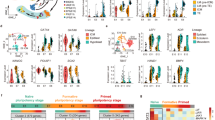Abstract
Regulation of early development can be directly interrogated in the embryo or can be studied in cultured cells isolated in the laboratory. New understanding of the developmental stages and the signalling requirements of the pig embryo have enabled the development of improved protocols for the derivation of pluripotent cells from early epiblasts. Here, we provide a detailed step-by-step description of the critical parameters required for isolation and establishment of these cells and how they can be used to study their developmental properties.
Access this chapter
Tax calculation will be finalised at checkout
Purchases are for personal use only
Similar content being viewed by others
References
Arnold SJ, Robertson EJ (2009) Making a commitment: cell lineage allocation and axis patterning in the early mouse embryo. Nat Rev Mol Cell Biol 10(2):91–103, doi:nrm2618 [pii] 10.1038/nrm2618
Brook FA, Gardner RL (1997) The origin and efficient derivation of embryonic stem cells in the mouse. Proc Natl Acad Sci U S A 94(11):5709–5712
Ying QL, Nichols J, Chambers I, Smith A (2003) BMP induction of Id proteins suppresses differentiation and sustains embryonic stem cell self-renewal in collaboration with STAT3. Cell 115(3):281–292, doi:S009286740300847X [pii]
Smith AG, Heath JK, Donaldson DD, Wong GG, Moreau J, Stahl M, Rogers D (1988) Inhibition of pluripotential embryonic stem cell differentiation by purified polypeptides. Nature 336(6200):688–690. doi:10.1038/336688a0
Brons IG, Smithers LE, Trotter MW, Rugg-Gunn P, Sun B, de Sousa C, Lopes SM, Howlett SK, Clarkson A, Ahrlund-Richter L, Pedersen RA, Vallier L (2007) Derivation of pluripotent epiblast stem cells from mammalian embryos. Nature 448(7150):191–195, doi:nature05950 [pii] 10.1038/nature05950
Tesar PJ, Chenoweth JG, Brook FA, Davies TJ, Evans EP, Mack DL, Gardner RL, McKay RD (2007) New cell lines from mouse epiblast share defining features with human embryonic stem cells. Nature 448(7150):196–199, doi:nature05972 [pii] 10.1038/nature05972
Vallier L, Alexander M, Pedersen RA (2005) Activin/Nodal and FGF pathways cooperate to maintain pluripotency of human embryonic stem cells. J Cell Sci 118(Pt 19):4495–4509, doi:118/19/4495 [pii] 10.1242/jcs.02553
Honda A, Hirose M, Ogura A (2009) Basic FGF and Activin/Nodal but not LIF signaling sustain undifferentiated status of rabbit embryonic stem cells. Exp Cell Res 315(12):2033–2042, doi:S0014-4827(09)00049-4 [pii] 10.1016/j.yexcr.2009.01.024
Alberio R, Croxall N, Allegrucci C (2010) Pig epiblast stem cells depend on activin/nodal signaling for pluripotency and self-renewal. Stem Cells Dev 19(10):1627–1636. doi:10.1089/scd.2010.0012
Telugu BP, Ezashi T, Sinha S, Alexenko AP, Spate L, Prather RS, Roberts RM (2011) Leukemia inhibitory factor (LIF)-dependent, pluripotent stem cells established from inner cell mass of porcine embryos. J Biol Chem 286(33):28948–28953, doi:M111.229468 [pii] 10.1074/jbc.M111.229468
Rodríguez A, Allegrucci C, Alberio R (2012) Modulation of pluripotency in the porcine embryo and iPS cells. PLoS One 7(11), doi:10.1371/journal.pone.0049079
Fujishiro SH, Nakano K, Mizukami Y, Azami T, Arai Y, Matsunari H, Ishino R, Nishimura T, Watanabe M, Abe T, Furukawa Y, Umeyama K, Yamanaka S, Ema M, Nagashima H, Hanazono Y (2013) Generation of naive-like porcine-induced pluripotent stem cells capable of contributing to embryonic and fetal development. Stem Cells Dev 22(3):473–482. doi:10.1089/scd.2012.0173
Author information
Authors and Affiliations
Editor information
Editors and Affiliations
Rights and permissions
Copyright information
© 2013 Springer Science+Business Media, New York
About this protocol
Cite this protocol
Rodriguez, A., Contreras, D.A., Alberio, R. (2013). Isolation and Culture of Pig Epiblast Stem Cells. In: Alberio, R. (eds) Epiblast Stem Cells. Methods in Molecular Biology, vol 1074. Humana Press, Totowa, NJ. https://doi.org/10.1007/978-1-62703-628-3_8
Download citation
DOI: https://doi.org/10.1007/978-1-62703-628-3_8
Published:
Publisher Name: Humana Press, Totowa, NJ
Print ISBN: 978-1-62703-627-6
Online ISBN: 978-1-62703-628-3
eBook Packages: Springer Protocols



